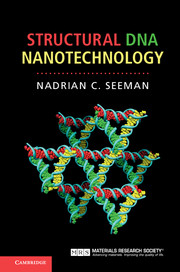Book contents
- Frontmatter
- Contents
- Preface
- 1 The origin of structural DNA nanotechnology
- 2 The design of DNA sequences for branched systems
- 3 Motif design based on reciprocal exchange
- 4 Single-stranded DNA topology and motif design
- 5 Experimental techniques
- 6 A short historical interlude: the search for robust DNA motifs
- 7 Combining DNA motifs into larger multi-component constructs
- 8 DNA nanomechanical devices
- 9 DNA origami and DNA bricks
- 10 Combining structure and motion
- 11 Self-replicating systems
- 12 Computing with DNA
- 13 Not just plain vanilla DNA nanotechnology: other pairings, other backbones
- 14 DNA nanotechnology organizing other materials
- Afterword
- Index
- References
6 - A short historical interlude: the search for robust DNA motifs
Published online by Cambridge University Press: 05 December 2015
- Frontmatter
- Contents
- Preface
- 1 The origin of structural DNA nanotechnology
- 2 The design of DNA sequences for branched systems
- 3 Motif design based on reciprocal exchange
- 4 Single-stranded DNA topology and motif design
- 5 Experimental techniques
- 6 A short historical interlude: the search for robust DNA motifs
- 7 Combining DNA motifs into larger multi-component constructs
- 8 DNA nanomechanical devices
- 9 DNA origami and DNA bricks
- 10 Combining structure and motion
- 11 Self-replicating systems
- 12 Computing with DNA
- 13 Not just plain vanilla DNA nanotechnology: other pairings, other backbones
- 14 DNA nanotechnology organizing other materials
- Afterword
- Index
- References
Summary
So far, we have been talking about DNA branched motifs and the various things we could make from them, often by holding them together with sticky ends. Here, we want to talk about motifs and cohesion that work, to a pretty good approximation, in the same way that structures and strong glues work on the macroscopic scale. It may seem that there is almost no need for this chapter, but in fact the lack of robust motifs was the major stumbling block to building periodic arrays and DNA nanomechanical devices in the late 1980s and much of the 1990s. It's worth thinking about. Just to be clear about what we mean, we'll define a rigid component as one that can specify the vectors of DNA double helix axes (and hence the angles between them) within limits of flexibility no greater than those of linear duplex DNA.
Periodic arrays need to be made from components that are fairly rigid. Anyone familiar with crystals knows that the structures derived from them are produced by summing up Fourier series, where the amplitudes are experimentally available and the phases are derived by a variety of methods. Fourier series are periodic sinusoidal functions, sines and cosines. These are functions that correspond to projections of the radius of a circle as it traverses the circular trajectory. It is clear from this relationship that designs that are aimed at making periodic functions must be prevented from cyclizing, primarily by rigidity, so that the cycles do not poison the growth of the lattice. In a similar fashion, robust nanomechanical devices function like their analogs on the macroscopic scale, by changing structural states without undergoing major deformations or multimerization or breakdown as a consequence of thermal noise. Rigidity is a requirement for robustness in nanomechanical devices, although it is possible and sometimes useful to make devices that are not robust.
The need to discover robust motifs was apparent fairly early in the history of this field. A 3-arm junction with sticky ends was designed and purchased. The naïve notion behind this junction was that six 3-arm junctions would self-assemble to look like a hexagon, as shown in Figure 6-1. There were three different strands, shown as red, blue, and green.
- Type
- Chapter
- Information
- Structural DNA Nanotechnology , pp. 88 - 96Publisher: Cambridge University PressPrint publication year: 2016



